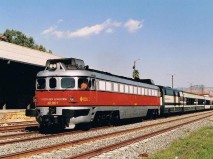1968 Дизель-гидравлический локомотив 353-005 Talgo
Country of origin - Germany
Manufacturer - Krauss-Maffei
Maximum speed - 180 km / h
Power - 235 hp (175 KW)
en.wikipedia.org
The RENFE Class 353, formerly known as the T-3000 are a class of diesel-hydraulic locomotives built by Krauss-Maffei for express trains in Spain.
The class could be described as the bigger and better version of the RENFE Class 352, being similar in design, and from the same builder, but with more power and also two cabins to simplify operation.
They were delivered between 1968 and 1969, built to a similar two-engined hydraulic transmission design as the Class 352 but with Maybach 12-cylinder engine developing more power, 1,500 hp (1,100 kW) (at 1600 rpm) each, giving a tractive effort of 268 kN (60,000 lbf). Built with two interior walkways via the cabins, the locomotives were a little heavier than their predecessors at 88 t (87 long tons; 97 short tons).
The locomotives were fitted with coupling screws and Scharfenberg couplers. Auxiliary generators provide electrical power for the coaches.
Two sets of standard gauge bogies were also supplied, for cross border work (bogie exchange).
The locomotives were painted in red-silver.
A total of five diesel were acquired to pull the Talgo III coaches at a record speed of over 220 km/h (140 mph). Their commission was related to the inauguration of the Talgo III RD (dual gauge) coached train from Madrid to Paris via Burgos, Vitoria, Hendaya and Bordeaux.
The trains also worked other international trains such as Barcelona to Geneva via Narbonne, Montpellier and Culoz, and the Paris to Barcelona; taking charge of the train after it passed the change of gauge to broad Iberian gauge at the stations of Irún and Portbou.
The mass electrifications in the eighties reduced the radius of action of both the Class 352 and Class 353, operating primarily in the axes Badajoz / Lisbon, Granada / Almería, Murcia / Cartagena and direct corridor from Madrid to Burgos.
The standard gauge bogies found a use unexpected at the time of the locomotives inception – in 1991 was used to tow a Talgo pendular train on the high speed Madrid to Seville AVE line.
The class was retired on 25 September 2003. The 353-005-2 is preserved in working condition at the museum of Vilanova.
This class once had its glory days, because for some time it held the world speed record for diesel traction.
In May 1972, one of them reached a speed of 222 km/h (138 mph) between Guadalajara and Azuqueca de Henares. Between Alcázar de San Juan and Rio Záncara, on 4 May 1978, 353-001 reached 230 kilometres per hour (140 mph) and held the diesel speed record for some time.









